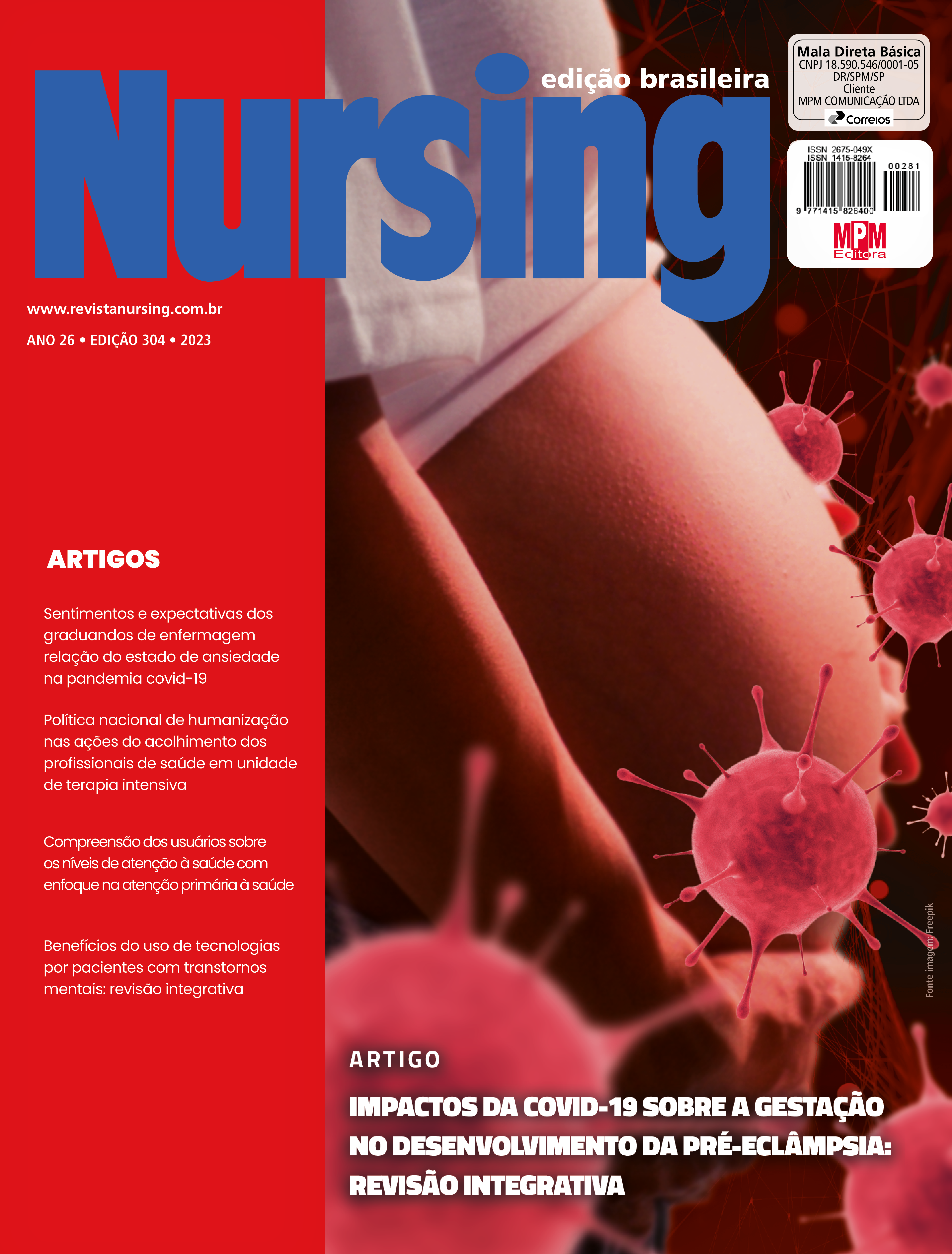BENEFITS OF THE USE OF TECHNOLOGIES BY PATIENTS WITH MENTAL DISORDERS: AN INTEGRATIVE REVIEW
DOI:
https://doi.org/10.36489/nursing.2023v26i304p9912-9915Keywords:
Technology, Child Health, Mental Disorders, Mental HealthAbstract
Objective: To investigate in the literature the use of technologies in mental disorders. Methods: This is an integrative literature review based on the identification of keywords, review of secondary sources for knowledge of the proposed theme, search in the literature for primary sources to compose this review and thorough reading of the selected articles. Results: There have been great contributions in technology in patients with mental disorders. Several benefits have been observed with the use of virtual reality, mobile applications, sensors and the use of robots in the treatment of panic disorders, post-traumatic stress, phobias, anorexia, body image disorders and compulsive eating disorders and the decrease of social anxiety . Conclusion: It is concluded how important technology can be in helping to care for patients with mental disorders and how much this area is still growing. Reading the articles reveals a gap in public policies aimed at the use of these technologies in assisting the population.
References
- Maples-Keller JL, Bunnell BE, Kim SJ, Rothbaum BO. The Use of Virtual Reality Technology in the Treatment of Anxiety and Other Psychiatric Disorders. Harvard review of psychiatry, 25(3), 103–113. 2017. https://doi.org/10.1097/HRP.0000000000000138
- Mohr DC, Burns MN, Schueller SM, Clarke G, Klinkman M. Behavioral intervention technologies: evidence review and recommendations for future research in mental health. General hospital psychiatry, 35(4), 332–338. 2013. https://doi.org/10.1016/j.genhosppsych.2013.03.008
- Costa DES, Rodrigues S de A, Alves R de CL, Silva MRF da, Bezerra ADC, Santos DC dos, Freitas MC de, Oliveira PE de, Nunes SF, Silva VC da, Nascimento CEM do. The Influence of Technologies on the mental health of the elderly in times of pandemic: na integrative review. RSD [Internet]. 2021Feb.4 [cited 2023Jul.12];10(2):e8210212198. Available from: https://rsdjournal.org/index.php/rsd/article/view/12198
- Brito C. Héctor, Vicente P. Benjamín. Realidad virtual y sus aplicaciones en trastornos mentales: una revisión. Rev. chil. neuro-psiquiatr. [Internet]. 2018 Jun [citado 2023 Jul 12] ; 56( 2 ): 127-135. Disponible en: http://www.scielo.cl/scielo.php?script=sci_arttext&pid=S0717-92272018000200127&lng=es. http://dx.doi.org/10.4067/s0717-92272018000200127.
- Bauer M. Amy, Hodson S, Bechtel M. Jared, Fortney C. John. Applying the Principles for Digital Development: Case Study of a Smartphone App to Support Collaborative Care for Rural Patients With Posttraumatic Stress Disorder or Bipolar Disorder. Journal of Medical Internet Research [Internet]. 2018; 20(6):e10048. Available from: https://doi.org/10.2196/10048
- Broome ME. Integrative Literature Reviews for the Development of Concepts. In: Rodgers, B.L. and Knafl, K.A., Eds., Concept Development in Nursing: Foundations, Techniques and Applications, 2000. W. B. Saunders Company, Philadelphia, 231-250.
- Mendes DS. Karina, Silveira CCP. Renata, Galvão M. Cristina. Revisão integrativa: método de pesquisa para a incorporação de evidências na saúde e na enfermagem. Texto e Contexto - Enfermagem [Internet]. 2008; 17(4). Available from: https://doi.org/10.1590/S0104-07072008000400018
- Caetano R, Silva AB, Guedes ACCM, Paiva CCN de, Ribeiro G da R, Santos DL, et al. Desafios e oportunidades para telessaúde em tempos da pandemia pela COVID-19: uma reflexão sobre os espaços e iniciativas no contexto brasileiro. Cad Saúde Pública [Internet]. 2020;36(5):e00088920. Available from: https://doi.org/10.1590/0102-311X00088920
- Ferrari SML, Pywell SD, Costa ALB da, Marcolino TQ. Grupos de terapia ocupacional em telessaúde na pandemia de Covid-19: perspectivas de um Hospital-Dia de Saúde Mental. Cad Bras Ter Ocup [Internet]. 2022;30:e3019. Available from: https://doi.org/10.1590/2526-8910.ctoRE22883019
- Douglas SN, Shi Y, Das S, Biswas S. Validation of Wearable Sensor Technology to Measure Social Proximity of Young Children With Autism Spectrum Disorders. Focus on Autism and Other Developmental Disabilities. 2022. 37(1), 24–33. https://doi.org/10.1177/10883576211028223
- Vaghetti AO. César, Alves K. Deborah, Ramson P. Bianca, Bandeira F. Lucas, Ferreira R. Adilson. Gamepad: utilizando exergames para a promoção da saúde e inclusão social de pessoas com deficiência [Internet]. 2022; 26(1). Available from: DOI: https://doi.org/10.25110/arqsaude.v26i1.2022.8111
- Kumazaki H, Muramatsu T, Yoshikawa Y, Matsumoto Y, Ishiguro H, Kikuchi M, Sumiyoshi T, Mimura M. Optimal robot for intervention for individuals with autism spectrum disorders. Psychiatry and clinical neurosciences, 2020. 74(11), 581–586. https://doi.org/10.1111/pcn.13132
- Yoshida A, Kumazaki H, Muramatsu T, Yoshikawa Y, Ishiguro H, Mimura, M. Intervention with a humanoid robot avatar for individuals with social anxiety disorders comorbid with autism spectrum disorders. 2022. Asian journal of psychiatry, 78, 103315. https://doi.org/10.1016/j.ajp.2022.103315
- Kurita H, Miyake Y, Katsuno K. Reliability and validity of the Childhood Autism Rating Scale--Tokyo version (CARS-TV). Journal of autism and developmental disorders, 19(3), 389–396. 1989. https://doi.org/10.1007/BF02212937








